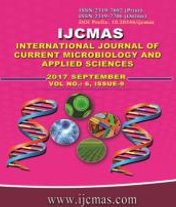


 National Academy of Agricultural Sciences (NAAS)
National Academy of Agricultural Sciences (NAAS)

|
PRINT ISSN : 2319-7692
Online ISSN : 2319-7706 Issues : 12 per year Publisher : Excellent Publishers Email : editorijcmas@gmail.com / submit@ijcmas.com Editor-in-chief: Dr.M.Prakash Index Copernicus ICV 2018: 95.39 NAAS RATING 2020: 5.38 |
Stalk rot in maize caused by Fusarium moniliforme has been a concern in majority of maize growing areas. There are no hybrids resistant to this disease. A study was conducted to identify the suitable strategies for effective mitigation of stalk rot. Biocontrol agents were tested by seed treatment and soil application in comparison with chemical seed treatment usually followed for soil borne diseases. Among the different treatments, seed treatment with T. viride and P. fluorescens at 2.5g each/kg of seed and soil application of 1.25kg/h each fortified with 250kg of FYM had lowest stalk rot of 6.07 per cent during 2014 and 8.13 per cent during 2015. The pooled disease incidence was 7.10 per cent. The treatment was statistically significant over other treatments which also recorded highest grain yield of 6044kg/h during 2014, 6067kg/h during 2015. The pooled yield was 6056kg/ha with a cost benefit ratio of 2.09. In untreated control stalk rot was 31.33 per cent during 2014, 42.10 per cent during 2015 and grain of 3378kg/h and 3444kg/h respectively during 2014 and 2015 with a pooled yield of 3411kg/h and cost benefit ratio of 0.78, the lowest among all. Seed treatment with Mancozeb 50% + Carbendazim 25% WS (sprint) 1g/kg & 2g/kg and Thiram 75WP (1g/kg) had more disease compared to biocontrol treated plots. The results once again reconfirm the beneficial characters of T. viride and P. fluorescensi against the pathogenic microbes in soil. Their ability to parasitize the pathogens by starvation, encourage growth of the plants by acting as defense agents and adoptability to different kinds of climatic fluctuations makes them more suitable for engaging against the stalk rot of maize. These will be free from residue effects and low cost in adoption.
 |
 |
 |
 |
 |